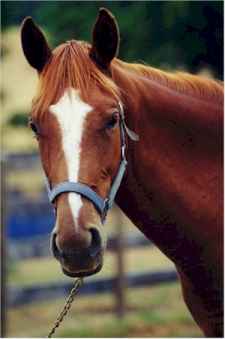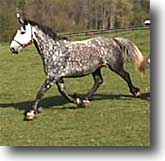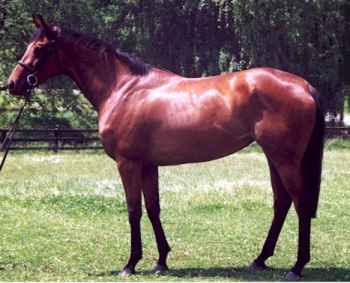The Irish Draught

Type and character:
The Irish Draught Horse is a very active, short-legged
and powerful horse with quality and substance. It is proud deep of girth and strong
in the back and quarters. Standing over a lot of ground, it has an exceptionally
strong and sound constitution. It has an intelligent and gentle nature and is
noted for being docile and sensible.
Example of a RID Mare.
Height:
Stallions:
15.3 h.h. to 16.3 h.h. approx.
Mares: 15.1 h.h. to 16.1 h.h. approx.
Bone:
Good,
strong and clean bone.
Head:
Bold eyes, set well-apart, longand well-set
on ears, wide across the forehead. Head should be generous and pleasant, not coarse,
a slight roman nose is permissible. The jaw bones should have plenty of room to
take the gullet and allow ease of breathing.
2yr
old
Shoulders, neck and front:
Shoulders should be clean-cut and powerful,
withers well-defined, not coarse; the neck set on high and carried proudly. The
chest is not to be too broad and beefy, the forearms should be long and muscular,
not caught in at the elbow; the knee large and generous, set near the ground;
the cannon bone straight and short, with plenty of flat, clean bone, never calf
kneed, i.e. not sloping forward from knee to fetlock. The bone must not be round
and coarse. The legs should be clean and hard, with a little hair permissible
at the back of the fetlock as necessary protection; the pastern stong and in proportion,
not short and upright nor too long and weak. The hoof should be generous and sound,
not boxy or contracted and there should be plenty of room at the heel.
Back,
hindquarters, body and hind legs:
The back to be powerful, the girth very deep,
the loins must not be weak but the mares must have enough room to carry the foal.
The croup to buttocks to be long and sloping, not short and rounded or flat topped;
hips not wide and plain; thighs strong and powerful and at least as wide from
the back view as the hips; the second thighs long and well developed; the hock
near the ground and generous, points of hocks not too close together or wide apart
but straight, they should not be out behind the horse but should be in line from
the back and the quarters through the heel to the ground, they should not be over
bent or in any way weak. The cannon bone, should be as for the foreleg short and
strong.
Action:
Smooth
and free but without exaggeration and not heavy or ponderous. Walk and trot to
be straight and true with good flexion in the hocks and freedom of the shoulders.
Colour:
Any
strong whole colour, including greys. White leg, above the knees or hocks, not
desirable.
The Irish Draught Horse was developed in Ireland from the Irish
"hobby" which was an energetic, small riding horse used for tending
the flocks and as a warhorse. Later, the blood of the heavier Norman horses, used
by the knights and Spanish Andalucian was added giving the hobby more bone and
size. With the arrival of the Thoroughbred, the Irish horse was further refined.
The Irish horse's main use in the early years was as a military horse. In
modern times the Irish Draught has been used for light farm work, pulling the
cart to market and fox hunting. The Irish Draught is a versatile animal with a
quiet disposition and enough stamina and athletic ability to excel in fox hunting.
The Irish studbook was started in the early 1900's for horses of the Irish Draught type and pedigree. The first inspectors were very careful to exclude horses with heavy draft blood, like the Clydesdale and Percheron, but Thoroughbred blood was allowed. The studbook started with 44 stallions and 375 mares. The numbers rose steadily and peaked in 1943, but with the mechanization of farming the numbers started to decline. Many of the mares were being bred for performance to Thoroughbred stallions and the number of purebreds fell to a dangerously low level. They are still considered an endangered breed.
In 1976 the Irish Draught Horse Society,
Ireland was formed to preserve and protect the breed. Today it has 19 branches
in Ireland and four international branches in Britain, New Zealand, Australia,
and North America. 
Irish
Draught Sport Horse